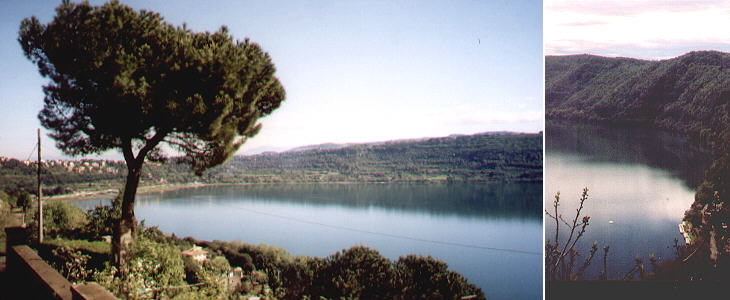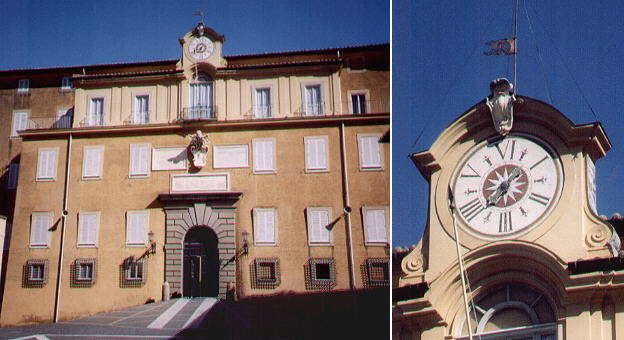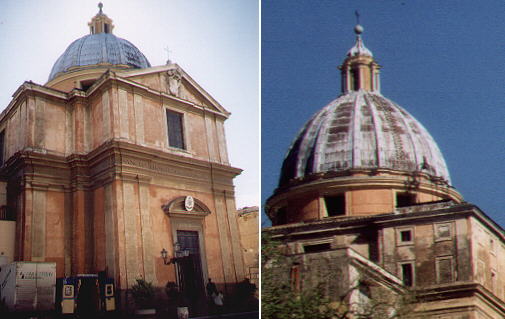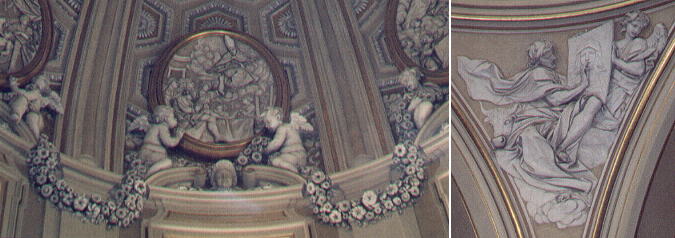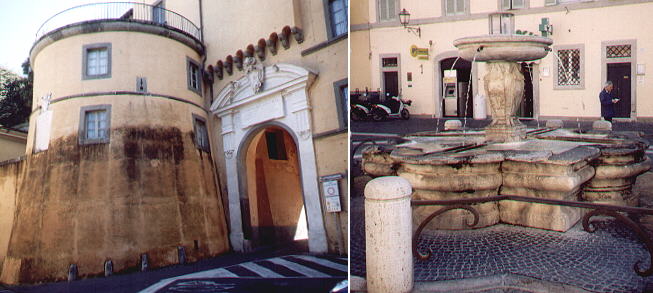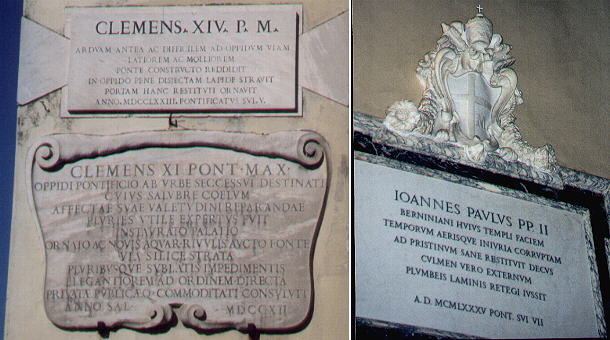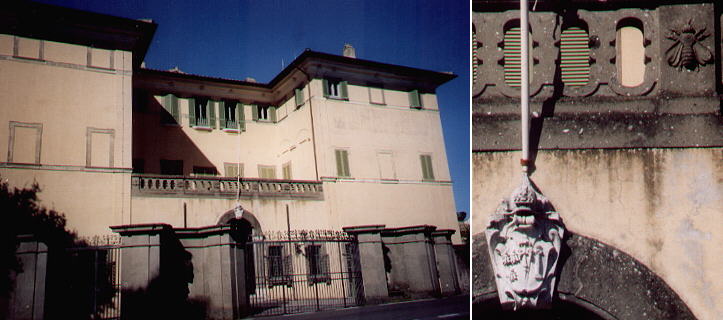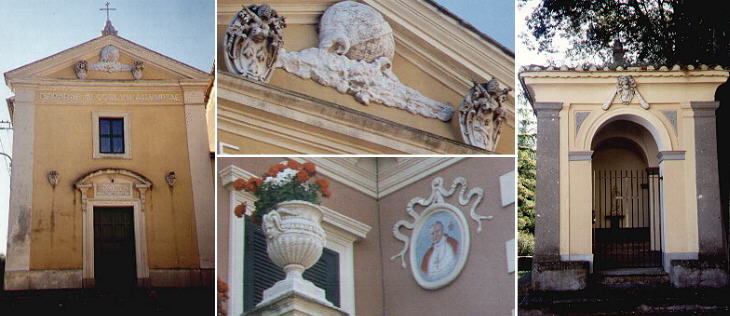

Castel Gandolfo, a small fiefdom of the Savelli situated on high ground above the Lake of Albano, became a direct possession of the popes towards the end of the XVIth century.
Pope Urbanus VIII selected it as the summer residence, a role which Castel Gandolfo still plays because the palace built in 1624 by Carlo Maderno, still belongs to the pope and enjoys the privilege of extraterritoriality.
Views over the lake
Notwithstanding its closeness to Rome, stringent environmental regulations have limited the number of modern
buildings overlooking the lake which on its southern shores retains its ancient woods.
Palazzo Pontificio
The palace was enlarged by several popes and their coats of arms or inscriptions celebrate these modifications.
The clock is still split into six sections following the Italian time counting system which was in place in Italy
until Napoleon imposed the move to the European system and which was reinstated in Rome after 1815 (for an explanation of the Italian hour click here).
S. Tommaso di Villanova
Pope Alexander VII commissioned to Gian Lorenzo Bernini the erection of a church in the main square of Castelgandolfo.
Due to space limitations Bernini chose a Greek cross shape. Bernini designed in his last years three churches:
each of them with a very different shape: circular in
S. Maria dell'Annunciazione in Ariccia, elliptical in
S. Andrea al Quirinale and based on a
Greek cross in this church of Castelgandolfo dedicated to S. Tommaso di Villanova.
Interior of S. Tommaso di Villanova: decoration of the inner dome and St Luke, patron of the painters
For the decoration of S. Tommaso di Villanova Bernini relied on a skilled team of assistants and in particular on
Antonio Raggi, a sculptor extremely talented in designing aerial stucco statues (you can see other works by Raggi in the ceiling of il Ges¨).
Entrance to the main square and fountain
Urbanus VIII protected the entrance to the town by adding to the papal palace a round tower projecting from it. He did the same in Palazzo del Quirinale.
The fountain of the main square (actually the only square) of Castelgandolfo was designed by Bernini who
followed a pattern common to many fountains in Rome.
Inscriptions celebrating works done by the popes
Due to its role as the summer residence of the popes, Castelgandolfo is full of papal coats of arms or inscriptions
celebrating improvements made by the popes. The two inscriptions by Clemens XI (1712) and Clemens XIV (1773) both make reference to
improving the access to the town and they are interesting because they show the change in style which took place in the second half of the XVIIIth century. The first inscription
follows the pattern of a Baroque cartouche an imitation of a roll of paper, while the second inscription adopts a much sober
ancient Roman format, which had already been adopted in 1743 for marking the boundaries of the Roman Rioni.
There are several coats of arms of Johannes Paulus II in Rome: in most cases they have been designed in very innovative
ways, but the example shown above (in S. Tommaso di Villanova) follows the most traditional Baroque pattern. The long inscription is also very much in line with the tradition, in the sense
that its length is in inverse proportion with the relevance of its contents (the repainting of the fašade and the restoration of parts of the (lead) roof).
Villa Barberini
The privilege of extraterritoriality applies also to a villa with a park reaching Albano which belonged to the Barberini who preferred
to stay in Castelgandolfo rather than in Frascati where the majority of the Roman families
had their
summer residence. The bees of the Barberini are almost everywhere and one of them ended up in the background of this page.
The coat of arms shows also the heraldic symbols of the Colonna family most likely due to the marriage between Don Taddeo
Barberini and Donna Anna Colonna.
En route to Albano: Chiesa del Convento dei Riformati, a portrait of Jophn Paul II, a chapel in Albano
There are two roads linking Castelgandolfo with Albano both called Galleria because the trees which flank them cover the view of the sky.
While Galleria di sotto (lower gallery) has lost its beauty because of the traffic, Galleria di sopra (upper gallery)
is still a very attractive promenade with views over the lake. Along the galleria there is a monastery with a church showing a globe between the coats of arms of Urbanus VIII and Sixtus V: the globe is a reference
to Collegio di Propaganda Fide, the institution founded by Urbanus VIII to coordinate the
missionary efforts of the church. The galleria ends at a chapel belonging to Convento dei Cappuccini in Albano.
Excerpts from Giuseppe Vasi 1761 Itinerary related to this page:
Castel Gandolfo, e monte Albano
Per due amenissime strade da Albano si passa a quel nobile castello, una sopra il colle, e l'altra di sotto, ricoperte ambedue di altissimi e
folti alberi, onde ne' calori estivi vi si gode lo spasseggio con un ombrosa frescura.
Da Gandolfo Savelli allora Principe di Albano fu eretto un castello in quell'amenissimo sito, di cui compiaciutosi poi Paolo V. e insieme
della delizia del suddetto lago, vi edific˛ un palazzo per suo diporto, cd essendo poi da Urb. VIII. accresciuto di comodi, e compito da
Alessandro VII. con deliziose fontane e comodissime strade, principi˛ a popolarsi, talmente che il medesimo Pontefice, per fare le sagre
funzioni, e dare a quelli abitatori maggior comodo, vi fece una nuova chiesa col disegno del Cav. Bernini, ed anche altri personaggi vi fecero
nobilissimi casini con giardini e ville.
|
Next step in your tour of the Environs of Rome: Ariccia
See my Home Page on Baroque Rome or my
Home Page on Rome in the footsteps of an
XVIIIth century traveller.
|


